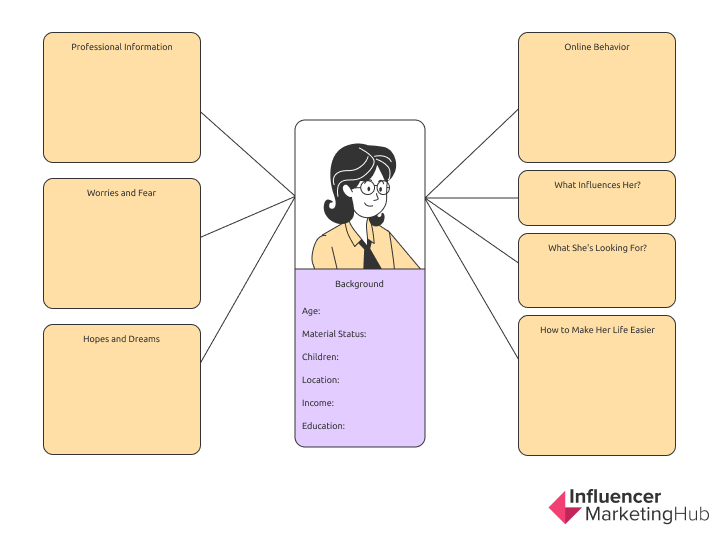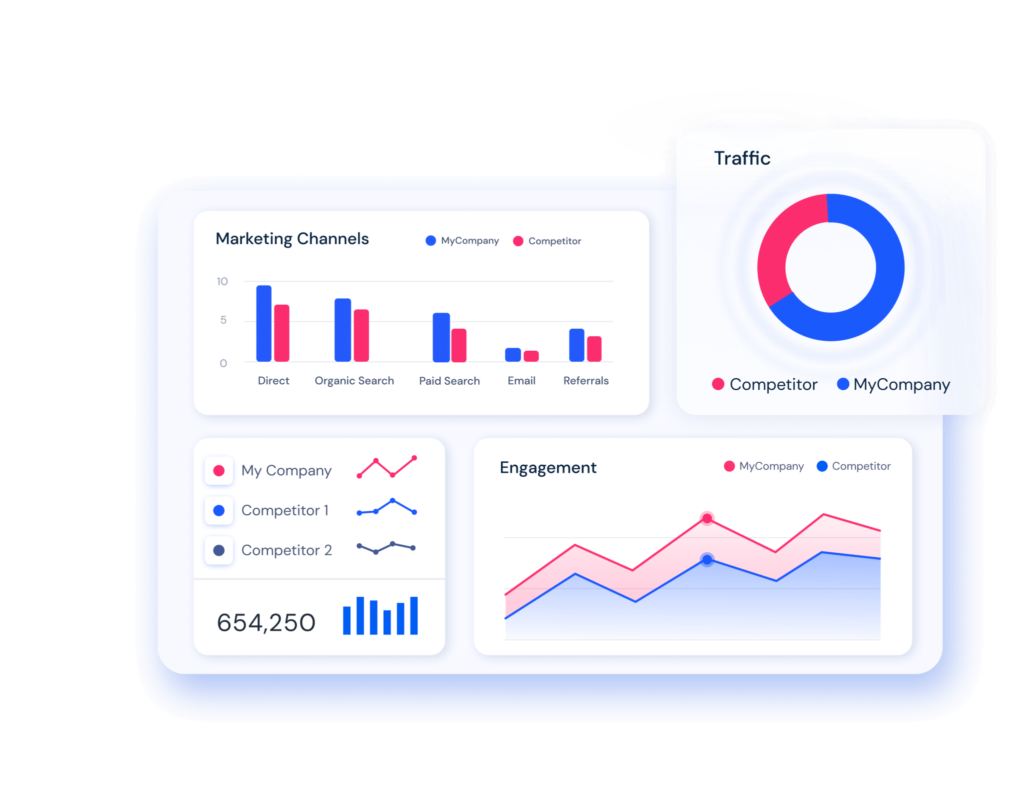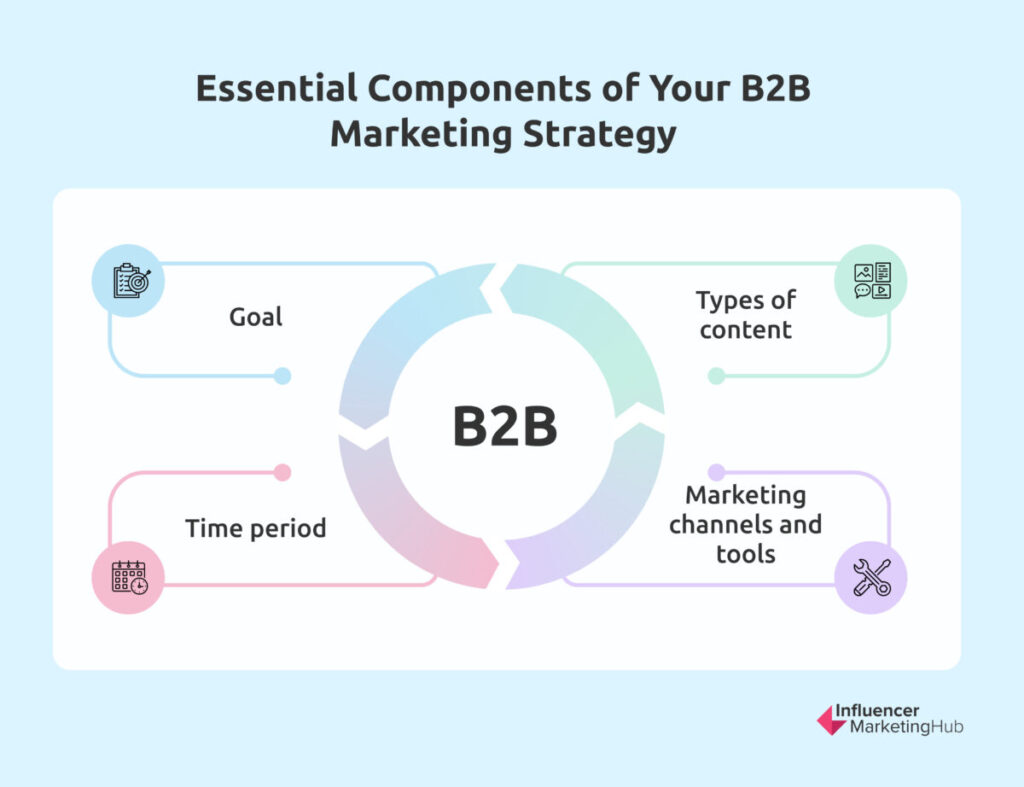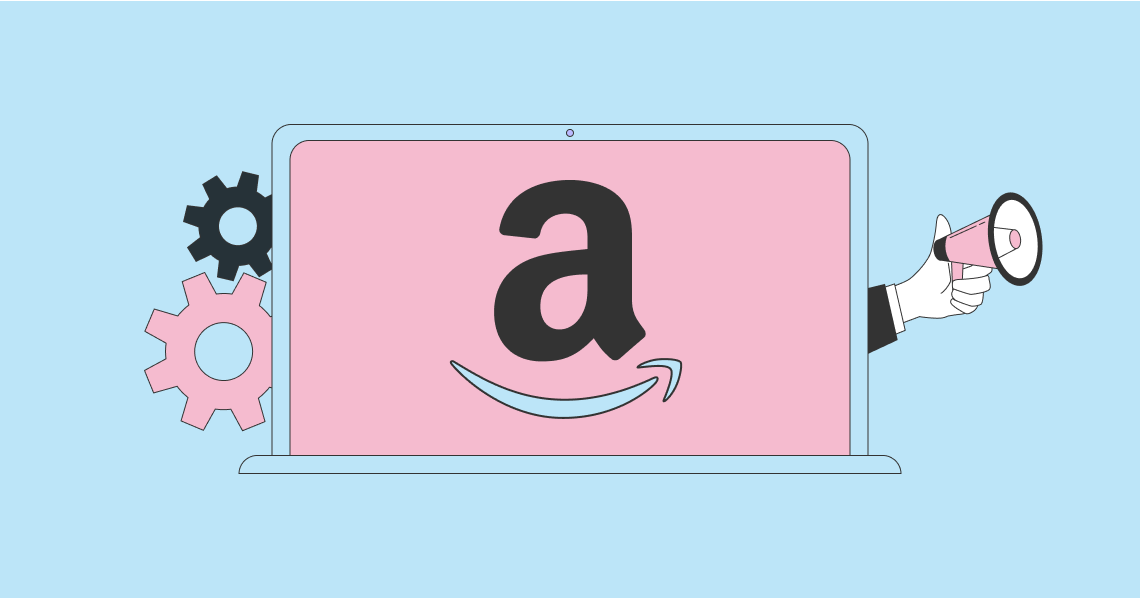Marketing to other business consumers is a whole different game as it involves more stakeholders and larger purchases. As such, B2B marketers often have to play the long game and carefully nurture prospects throughout a lengthy buying journey. This can make B2B marketing a bit more challenging, which is why we’ve created this post to guide you through the process.
If you’re new to the B2B landscape, this post serves as the ultimate guide to help you get started with B2B marketing. You’ll understand the key differences of marketing to B2B vs. B2C consumers and the different steps to execute your B2B marketing strategy. Let’s dive in.
The Ultimate Guide to B2B Marketing:
What is B2B Marketing?
B2B marketing refers to the process of marketing products or services to other businesses. For example, a company marketing its email marketing platform to other businesses would be considered B2B marketing. Similarly, an agency marketing its content development capabilities to companies that need help with content marketing would also be considered B2B marketing.
For example, Sprout Social sells a suite of tools intended to help businesses and marketers streamline their social media marketing efforts. So they regularly produce content and marketing materials aimed at a B2B audience.
Looking to refresh how you and your team plan a social campaign?
With our brief template, plan:
✅ Goals, objectives and target audiences
✅ Organic/paid activation plan
✅ Team operations, rituals and roles (using DACI framework)And more: https://t.co/QgPv5ETuNn
— Sprout Social (@SproutSocial) May 4, 2023
B2B vs. B2C Marketing: Understanding the Differences
What really makes B2B marketing different from B2C marketing? Sure, you’re marketing to other businesses, but it’s still people who do the purchasing on behalf of their companies. So what’s the big difference? Let’s give you a quick breakdown of the main differences between B2B marketing and B2C marketing.
- In B2C marketing, businesses are targeting consumers who are buying for themselves or their friends and family. As such, the purchasing decisions are typically only made at the individual level. Meanwhile, B2B marketing targets consumers who are buying on behalf of an entire organization. This means that the purchasing decisions may involve several stakeholders and would require conferring between different team members.
- As a result of the above, B2C marketing tends to involve shorter buying journeys. B2B marketing may take a longer time to yield results due to longer buying journeys.
- B2C marketing taps into the emotions of the target audience whereas B2B marketing focuses on promoting things such as financial incentives and ROI, which could be beneficial for the entire company.
- In B2C marketing, customers may want to learn a bit more about the product or service they’re buying. However, this educational process isn’t always a necessity as they can get most of the info they need from reviews and product descriptions. Meanwhile, B2B marketing involves educating the target audience and providing in-depth guidance before they’re ready to make a decision. That’s why you’ll see B2B companies such as ClearVoice constantly producing educational and informative content across their social media channels. This allows them to showcase their expertise and establish a relationship with the target audience before promoting their services.
- B2C marketing tends to focus on addressing short-term problems without necessarily building a long-term relationship with the customer. On the other hand, B2B marketing is all about establishing long-term relationships with other businesses and providing them with long-term solutions.
6 Steps for Successful B2B Marketing
We get it–it feels a bit intimidating to get started with B2B marketing if you’re new to it. To make the job easier for you, here are some essential steps that will help you find success with your B2B marketing efforts.

Step 1: Identify Your Goals
As with all types of marketing, it’s important to start your B2B marketing journey by laying out your goals. What do you wish to achieve through your efforts? Perhaps you want to attract more leads, drive traffic to your site, drive signups for your upcoming webinar, get people to sign up for your newsletter, and so on.
Having specific goals in place will help to lay the structure for the rest of your marketing efforts. It will determine the approach that would work best for you and help you assess the effectiveness of your strategy. That way, you’ll be able to present the results to relevant stakeholders and prove campaign ROI.
Step 2: Narrow Down Your Target Audience
Next, you need to have a clear idea of the type of people you want to target–whether it’s for your business as a whole or for one specific campaign. Define who your product or service is built for and who will get the most benefit out of it. In the case of B2B marketing, it’s usually a good idea to start out by listing the firmographic data of your target companies. This may include details such as:
- Industry. For example, you may target companies in the fintech industry. However, certain types of products (such as marketing tools) may be suitable across all industries.
- Company size and number of employees. Is your product built for small companies and home offices or large enterprises? Figure out how many employees they typically employ.
- Region or location. Is your offering only available to businesses based in North America? Or are you targeting larger regions?
- Revenue. How much revenue do these target companies bring in on an annual basis?
Once these details are established, you can start to define what your target audience looks like within those target companies. So you may list down demographic and psychographic data such as:
- Age
- Education level
- Job title
- Habits
- Behaviors
- Influences
- Pain points
This will allow you to create comprehensive buyer personas to use in your marketing. For example, you may be targeting individuals aged between 25 and 40 working as social media managers at medium to large enterprises based in North America. Considering their job title and age range, social media may be an effective channel to connect with them.

Step 3: Map Your B2B Customer Journey
With purchase journeys being much longer in the B2B industry, it’s important for businesses to understand the journey their customers go through so they can nurture them at every stage. The goal is to maintain their interest along the journey, drive them closer to a purchase decision, and stay top-of-mind when they do make that decision. This makes it crucial to map your B2B customer journey so you can understand how to engage them at different stages.
There are three stages involved in a typical B2B buyer’s journey–awareness, consideration, and decision. The awareness stage is when the buyer is starting to be aware of the problem that needs solving. The consideration stage is when they start to look around for solutions and compares the different options available. The decision stage is when they’re finally ready to make the purchase.
B2B marketers will need to create a comprehensive marketing strategy to nurture prospects at all three stages. So, for example, they may create ads and social media posts to generate the interest of buyers who are still at the awareness stage. They may develop in-depth blog posts and informative content to nurture them at the consideration stage. Finally, they may offer demos and free trials to nudge them closer to purchase at the decision stage.
You can use customer journey mapping software to visualize a typical buying journey for your products. This will allow you to better understand the different stages that buyers go through before making a purchase. You can then strategically plan your marketing tactics to maintain the interest of prospects who are at different stages of the buying journey.

Source: uxpressia.com
Step 4: Run a Competitor Analysis
For your business to stand out with B2B marketing, you need to have an idea of what you’re up against. This will help you understand how to differentiate yourself from the competition and what’s currently available to your target audience. A detailed analysis of your competitors will help you get a better understanding of how to market your business in a way that helps you get ahead of the curve.
Your competitive analysis should involve looking at the different marketing channels and approaches that your competitors are currently using. Which platforms are they utilizing and how are they marketing themselves on those platforms? What types of posts and content are their audience responding to and are there any missed opportunities?
For instance, you might find that your competitors hardly ever post about their employees even though the employee spotlight post from months ago saw a ton of engagement. This could be a sign that your target audience wants to see more content about the people behind the brand, which your competitors aren’t realizing yet. You could create a strategy to include employee spotlight and appreciation posts every week or so to keep this audience engaged and build a human connection with them.
There are plenty of competitor analysis software solutions that will help you take a closer look at different aspects of your competitors’ marketing strategies. Depending on the tool you use, you should be able to get a breakdown of their SEO efforts, their content marketing strategy, their social media marketing strategy, and so on.

Source: similarweb.com
Step 5: Identify Key Marketing Channels
From the research you’ve done so far, you should have a clear idea of which marketing channels seem to be the most effective. Your target audience analysis should have told you which channels are most popular with them. Is your target audience active on social media? If so, which platforms are they using most frequently, especially to research B2B companies?
Meanwhile, your competitor analysis should have helped you identify the key channels they’re utilizing and the ones they’re failing to take advantage of. Which social media platforms are your competitors leveraging? Are they running an active blog? Are they marketing their content through third-party publications?
Based on this information, you can narrow down the most vital marketing channels to leverage for your own B2B marketing efforts. For instance, you may notice that your competitors have a blog but hardly ever update it. At the same time, your target audience tends to favor long-form content that educates them before they make a buying decision. So you take advantage of the untapped opportunity and resolve to maintain an active company blog.
To further organize your efforts, you could even list the key marketing channels you’d be utilizing for buyers at different stages of the buying journey. This may involve the use of social media and blogs at the awareness stage while email may be vital at the consideration stage, for example.
Step 6: Develop Your B2B Marketing Strategy
Finally, it’s time to put all this together to build a solid B2B marketing strategy outlining your goals, target audience, marketing channels, and tactics. You may do this for a specific campaign or time period to test for efficacy and then make improvements. This will allow you to make the most of your marketing dollars and increase your ROI.
Create a documented B2B marketing strategy that provides a detailed list of approaches that will be included in this campaign. Ideally, this should include the following key details:

- Goal – What you want to achieve through this campaign (attracting leads, driving demo downloads, creating awareness, driving sales for a new product, etc.)
- Time period – Duration of the campaign (a month, a quarter, a year, etc.)
- Types of content – Social media posts, podcasts, webinars, blog posts, whitepapers, etc.
- Marketing channels and tools – Social media platforms, email, blog, third-party publications, search engine ads, social media ads, etc.
So, for example, your goal is to attract new leads for your business within a given quarter. In this case, your strategy may involve creating a lead magnet such as a data report, and promoting it through ads on LinkedIn. This will allow you to collect valuable lead data through the forms they submit to download the report. Alternatively, you may also host a webinar on a relevant topic and collect leads through registration forms.
Ready to Dive into B2B Marketing?
Getting into the world of B2B marketing may be intimidating at first. But with in-depth research and strategic planning, you should be able to get a strong start. Make the most of the tips and ideas we’ve shared above to build your very first B2B marketing strategy and reach a relevant B2B audience.
Frequently Asked Questions
What are the four pillars of B2B marketing?
Content, connection, communications, and conversion are the four pillars of B2B marketing.
What is the rule of seven in B2B sales?
According to the rule of seven, the average B2B buyer must be exposed to your company at least seven times before they’re ready to make a purchase.
What is a B2B marketing strategy?
A B2B marketing strategy is a strategy for promoting your products or services to other businesses.
How do I start B2B marketing from scratch?
You can start B2B marketing from scratch by understanding your target audience, mapping their journey, conducting competitor analysis, identifying your key marketing channels, and developing a strategy accordingly.
How can I generate B2B leads?
There are a number of ways to generate B2B leads–whether it’s through your website live chat, display advertising, search engine marketing, social media marketing, or email outreach.


